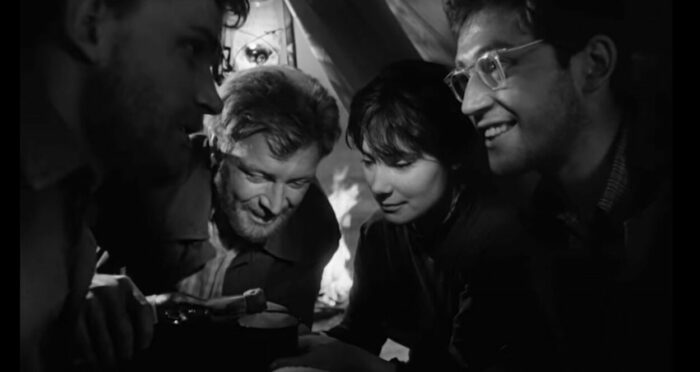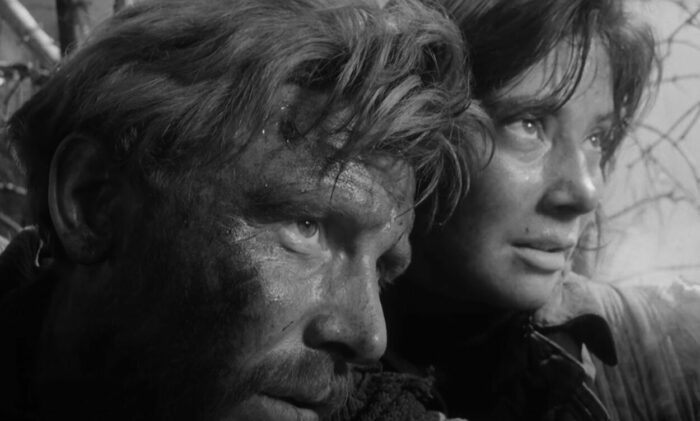Mikhail Kalatozov faced high expectations after his anti-war masterpiece The Cranes Are Flying (1957) had triumphed at the Cannes Film Festival 1958, winning its most coveted award—the Palme d’Or. Made just two years after this film, Letter Never Sent was Kalatozov’s cinematic foray into the wilderness of the Siberian taiga, where a geological expedition is set to discover precious gemstones while facing increasingly volatile weather conditions. Partnering once again with The Cranes Are Flying cinematographer Sergey Urusevsky, Kalatozov produced a film of staggering beauty and conviction that managed to overcome its shaky plot conflict and overly sentimental elements through its masterful direction, cinematography, and acting. Rather than being just another social realist film about the heroism of the Soviet people, Letter Never Sent can now be considered one of the unlikely unrecognised “pioneers”, anticipating and already echoing Andrei Tarkovsky’s nature-infused poeticism in Ivan’s Childhood (1962) and Larisa Shepitko’s unforgettably tragic characterisations in Wings (1966), as well as paving the way for the emergence of other more realist and less formulaic Soviet cinematic works, including those made by Kira Muratova and Sergei Parajanov.
Tbilisi-born Mikhail Kalatozov was a versatile Soviet director, making his debut with visually-impressive documentary Salt for Svanetia (1930), which focused on isolated people living in Svanetia, Georgia, and then producing such diverse films as biopic Valery Chkalov (1941) and comedy True Friends (1954). When Khrushchev’s “Thaw” period then almost demanded some light-hearted cinema that showcases the new-found optimism of the Soviet people (Height (1957), Carnival Night (1956)), Kalatozov went with a more sober content, being always open to using highly expressive cinematic techniques to achieve a picture of vigour and substance. Letter Never Sent is based on Valeri Osipov’s short story, which the latter penned after overhearing one of the stories told by Soviet geologists on his tour of Yakutia. And, the popularity of the theme of the Soviet geologists and their heroic work in the country at that time cannot be overstated since only in 1954 pioneering geologist Larisa Popugaeva found the country’s first ever diamondiferous kimberlite pipe.

Shot on location over an arduous eight months, Letter Never Sent boasts an opening sequence “to die for”: one long take (using camera mounted on a helicopter) captures our four protagonists, who have just been dropped off on a terra incognita to carry out their research, before slowly moving away from them to reveal the sheer vastness of the unexplored terrain and its primordial beauty. This is River Yenisey and its estuary, and the next shot sequence shows the four geologists, leader Kostya (Innokentiy Smoktunovskiy), Tanya (Tatiana Samoilova), Andrei (Vasiliy Livanov) and guide Sergey (Evgeniy Urbanskiy) making their way through seemingly impassable water terrain, while a hand camera follows closely their torturous process, inviting the audience to become an invisible party to this exciting, but also dangerous expedition.
While leader Kostya is engrossed in his letter writing to his wife, longing for his return, the rest of the group’s almost childish enthusiasm for finding diamonds in so remote a region soon gives way to some tension as Tanya and Andrei, allegedly two people secretly in love with each other, but not daring to confess, discover guide Sergey’s love letter to an unnamed girl. It is possible that Tanya now has two suitors, and the internal conflict is between rational and intellectual Andrei, and temperamental and manly Sergey. Tatiana Samoilova’s impressive sensitivity in front of a camera pays off as she again confronts the situation that faced her heroine in The Cranes Are Flying, embodying a similar free-spirited woman with the same nuance. Does the group’s seemingly hopeless search for diamonds also metaphorically represent looking for the end to their romantic or sexual tension? Does the clash between Sergey’s fiery personality and Andrei’s languid demeanour set the stage for the group’s forthcoming battle with both fire and water? There is even a hint of some inter-generational conflict as older Sergey, who must have seen and experienced more of the WWII events, displays a gloomier outlook on life than his younger, more naïve and carefree compatriots, Tanya and Andrei.

The quiet domesticity that the four geologists establish near the river only make the sudden cataclysmic events to follow even more pronounced, as the film’s extreme close-ups mingle with long-shots to underline the contrast between the group’s increasing claustrophobia within the close parameters of their “love triangle” (and their deep-seated hope of being victorious), on the one hand, and the sheer immensity of the surrounding nature (and the insurmountable task of finding any diamonds), on the other. When the group finally finds the traces of precious stones, they ask themselves: “can it be that we have now lived our lives not in vain?” Soon, however, the initial drama surrounding the relationship between Tanya, Andrei and Sergey is irreversibly “hijacked” by one intense survival-in-the-wilderness story, which spans the rest of the film. It is in the story’s second half that we finally see what was probably the initial intention of the film – to portray the man’s battle with the four prime elements of nature: water, earth, air and fire. It is impossible to escape musings on possible metaphors here: are these geologists forced “to cleanse” themselves by fire and water before the nature’s secrets are divulged to them and they are able to profit from them? Are the hardships they are enduring just these “ordeals” by water and fire? One shot even hints at the image of Adam and Eve being expelled from Paradise.
The film does not always handle its dramatic turning points subtly, but, yet again, Urusevsky’s exquisite cinematography more than compensates, and the camera often emerges as though it were really a fifth member of the expedition, a more heroic and inquisitive one, closely following the group, surprising the audience with its visual insights. In that way, every time the plot is in danger of becoming a tad emotionally manipulative, predictable or melodramatic, a surprising camera angle, a deceptive play of light and shadow or a sweeping panorama will again restore the faith in the direction.

If the camera or image can be considered the fifth member of the expedition, the music may be presumed the sixth. Nikolai Kryukov’s dramatic score impresses in those moments where it is most needed, making inroads or holding back interchangeably as the expedition becomes torn between hope and despair. However, it is not all dynamism music-wise in Kalatozov’s film because one scene shows our heroes tuning in to listen to their radio transmitter, their only link to the outside world, only to catch American pianist Van Cliburn’s touching rendition of Solovyov-Sedoi’s song “Moscow Nights”. And, if any sequence is capable of surpassing the film’s opening sequence, then it is the film’s closing one, which shows a similar crane shot, just before the audience had been treated to some moments of delicious suspense regarding the fate of one man from the expedition.
Once championed by Francis Ford Coppola, who funded the film’s restoration in 1995, Letter Never Sent might have also been rather unlucky at the time of its initial release. The film not only had the misfortune to share its cinematic year with immensely popular Ballad of a Soldier (1959) (that also competed in Cannes) and the tragic Dyatlov Pass incident, where a group of hikers died under mysterious conditions in the Ural mountains, but upon its nomination for the Cannes Film Festival 1960, the producers withdrew Letter Never Sent from the main competition allegedly to reshoot some scenes.
Seeing beyond the story’s narrative clichés, it is clear that Letter Never Sent also speaks a cinematic language of its own, a startling tongue that, with its every shot seemingly overriding any narrative dissatisfaction, imbues the film with a special aura. What metal looks its best when first unearthed? What may be needed to appreciate its true worth is a closer look, a dive into a relevant context. Similarly, Letter Never Sent requires the same careful consideration, at the end of which one may hopefully discover that the film is not some film-pebble languishing in the shadow of Kalatozov’s gold nugget, which is The Cranes of Flying, but a true cinematic gem, perhaps a bit rough around the edges, but still a precious stone to be cherished and preserved.



